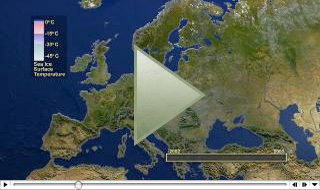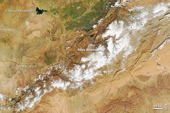
Lake Ice
 Lake ice displayed in this image of Lake Erie, acquired from the Terra MODIS instrument on 20th of February 2003.
Lake ice displayed in this image of Lake Erie, acquired from the Terra MODIS instrument on 20th of February 2003.
The formation of lake ice brings shipping and transportation on inland waterways to a standstill for several months each year in many northern areas. In addition to the impact on humans, the presence or absence of ice on lakes can have a major influence on the ecology of a region. The presence of ice can govern the viability of fish life in a lake, for example.
Lake ice formation, thickness and break-up are also key indicators of regional climate especially in data-sparse regions which characterize much of the Arctic (Palecki and Barry, 1986). Lakes that freeze each winter are good indicators of regional climate if key parameters such as the dates of freeze-up and break-up and maximum ice thickness are measured over a decade-scale time frame (Magnuson et al.,2000).
Some northern regions have experienced climate warming over the past few decades (or longer) as measured in the permafrost record and in meteorological records (Chapman and Walsh, 1993). Schindler et al. (1990) showed that air and lake temperatures in the Experimental Lakes Area of northern Ontario have increased by 2°C, and the length of the ice-free season has increased by 3 weeks, according to 20 years of observations.
 Photographs by D. K. Hall. Ice coring on a lake outside of Barrow, Alaska, April 1992. Hole in lake ice following extraction of an ice core.
Photographs by D. K. Hall. Ice coring on a lake outside of Barrow, Alaska, April 1992. Hole in lake ice following extraction of an ice core.
NOAA data have been used successfully to study lake ice on the Great Lakes. Because of the daily coverage of the NOAA satellites, data may be used operationally in spite of the fact that cloud cover obscures the surface for much of the time. Ice conditions are also of interest because open water areas or large leads (or openings) in the Great Lakes contribute moisture to feed major snow storms. Much work on the remote sensing of the Great Lakes has been accomplished (see Assel et al., 1994) and the Great Lakes Environmental research Laboratory.
References
Assel, R.A., T.E. Croley II and K. Schneider, 1994: "Normal daily temperatures and ice cover of
the Laurentian Great Lakes of North America," Abstract only, 51st Eastern Snow Conference, 15-16 June 1994, Dearborn, MI.
Chapman, W.L. and J.E. Walsh, 1993: "Recent variations of sea ice and air temperature in high
latitudes," Bulletin of the American Meteorological Society, 74:33-47.
Magnuson, J.J. et al., 2000, "Historical trends in lake and river ice cover in the Northern Hemisphere," Science, 289, p. 1743-1746.
Palecki, M.A. and R.G. Barry, 1986: "Freeze-up and break-up of lakes as an index of temperature
changes during the transition seasons: a case study in Finland," Journal of Climate and Applied
Meteorology, 25:893-902.
Schindler, D.W., K.G. Beaty, E.J. Fee, D.R. Cruikshank, E.R. DeBruyn, D.L. Findlay, G.A.
Linsey, J.A. Shearer, M.P. Stainton and M.A. Turner, 1990: "Effects of climate warming on lakes
of the central boreal forest," Science, 250:967-970.











